With trains, buses, trams and a metro system, Oslo residents and visitors are spoilt for choice with options for getting around the city. Here's how public transit works in Oslo.
Oslo city centre is compact and much of it can be navigated on foot. But the suburbs spread out for many miles, and some tourist attractions are outside the central area.
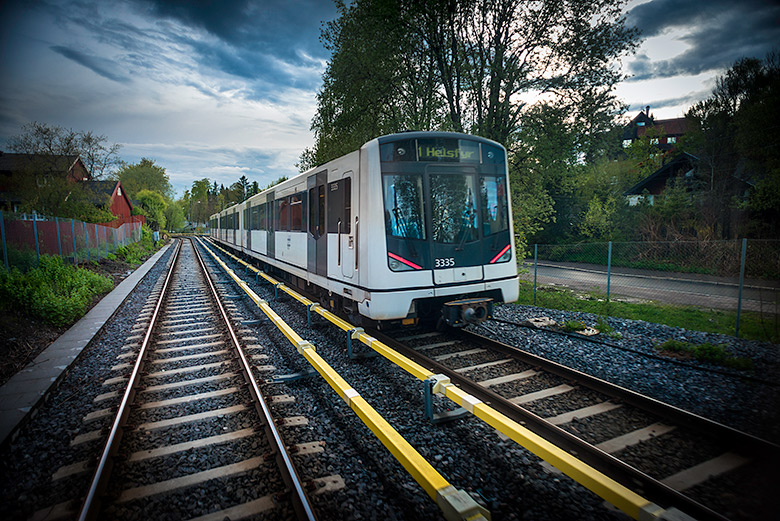
Thankfully, there is a very good integrated public transport system. Trains, light rail, trams, buses and ferries are on hand to move you around the city with ease.
Whether you’re in town on a city break or you’ve just relocated, you’ll likely want information about public transport in Oslo. Get comfy, because that’s exactly what I’m going to cover today.
Public transport in Oslo and Akershus is coordinated by Ruter AS. Individual operators are contracted to run the individual services. But it’s Ruter that has responsibility for planning, pricing, coordinating and managing the system as a whole.
Options for getting around Oslo
I often get asked “which option is best” by visitors to Oslo. They want to know if the train, light rail, tram or bus is the best option for them.
Read more: Oslo Travel Guide
The answer, of course, is that it depends! There is no one right answer. The best public transport option for you depends on where you’re staying and where you’re going.
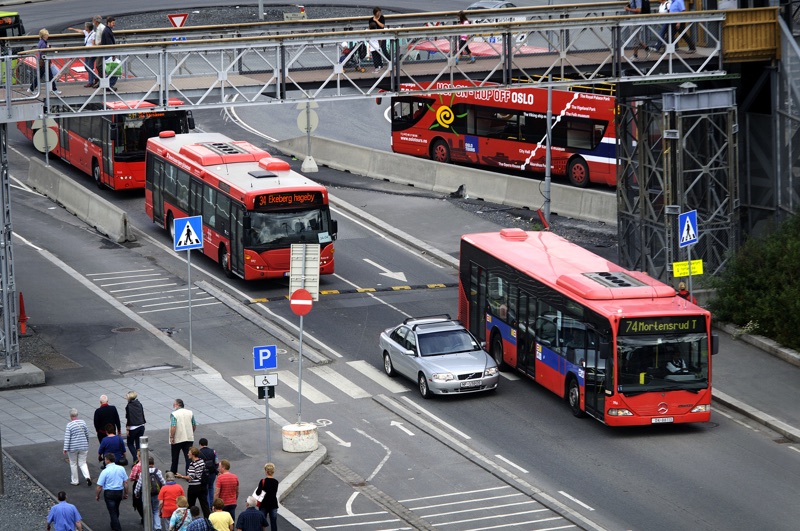
This is of course even more true for new residents of Oslo. The best option for you is likely to be the one that’s most convenient from your home address. For those visiting the city, here are some of the major sights accessible via various means of transport:
Trains: Best suited for commuters and business travel.
Metro (T-Bane): Holmenkollen ski jump, Frognerseteren, Ullevaal Stadium.
Tram: Ekeberg Park, Barcode, Aker Brygge, Vigeland Park.
Bus: Bygdøy museums.
Ferry: Oslofjord islands.
Where to buy public transport tickets in Oslo
Whichever ticket you go for, you'll need to get a Ruter electronic card, which is available from any staffed station, plus many kiosks such as Narvesen and Deli de Luca.
On the card you can store a period ticket (e.g. 30-day ticket) or credit, which can be used to pay for single tickets. You can read more about the electronic ticket here. Alternatively, you can use the mobile app to purchase and store your ticket.
To validate the ticket, you must touch the card to the readers situated at the train/metro stations or on board the bus/tram.
Read more: Oslo In Pictures
If you have a period pass, the expiry date will display on the screen, otherwise the credit will be deducted from the stored value. It's a simple, user-friendly system that just works.
Trains in Oslo
Several commuter lines exist in and around Oslo including a popular one between Oslo and Drammen, via Skøyen, Lysaker and Asker. Be warned, these trains get very busy in rush-hour! You can check timetables over at Vy.
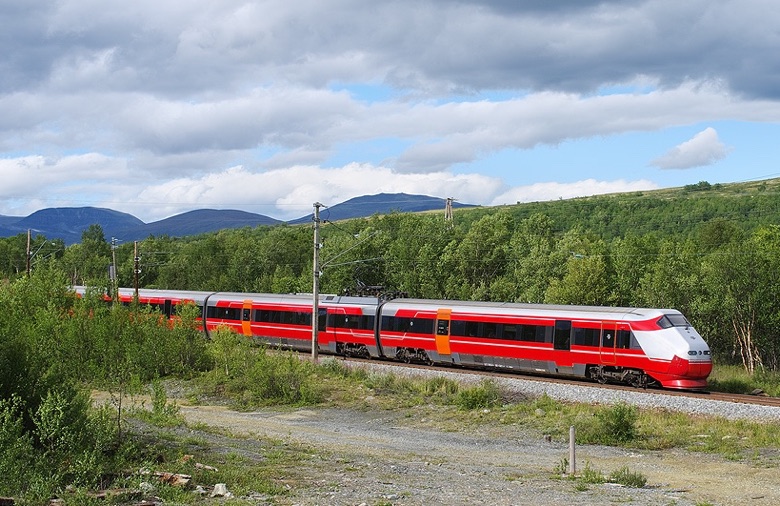
They are of limited use for travellers, though. The one exception is the local line that runs between Oslo and the main airport. It's a much cheaper option than the Airport Express Train and takes only a few minutes more. Check out our Oslo Airport guide to learn more about these options.
Oslo Metro (T-Bane)
Light rail or metro systems are always popular with travellers the world over as they tend to be one of the more efficient ways to get around an urban area. In Oslo the metro system is known as the T-Bane. It's a very popular with both commuters and leisure travellers.
There are a variety of lines covering the city, numbered 1 to 5. All lines converge through the city centre in a shared tunnel. That means that the stations at Majorstuen, Nationaltheatret, Stortinget, Jernbanetorget, Grønland and Tøyen stations, you can pick up any T-Bane line.
Line 1 is popular with tourists as the primary means of getting to Holmenkollen ski jump and the national ski arena. It's also used to reach the hiking and skiing trails of Nordmarka by way of the final station, Frognerseteren.
A new central tunnel is planned to relieve congestion on the network, as the current tunnel limits capacity. However, any changes will be years away yet. One confirmed extension useful for business commuters is the new line from Majorstuen to Fornebu. The latest network map can be downloaded here.
Trams in Oslo
The tram (trikk in Norwegian) is an old, slow system of moving around Oslo. Yet it provides a critical link to many residential parts of the city. There are also many destinations that visitors can reach on the tram. They include Vigeland Sculpture Park, Bislett Stadion, Aker Brygge and Grünerløkka.
A new fleet of trams is on its way along with several important line extensions which should revitalise the network. The new trams are much quieter and more efficient. Importantly for the elderly or those with mobility issues, they will also have doors down at pavement level. Many of the old trams had narrow stairs to board.
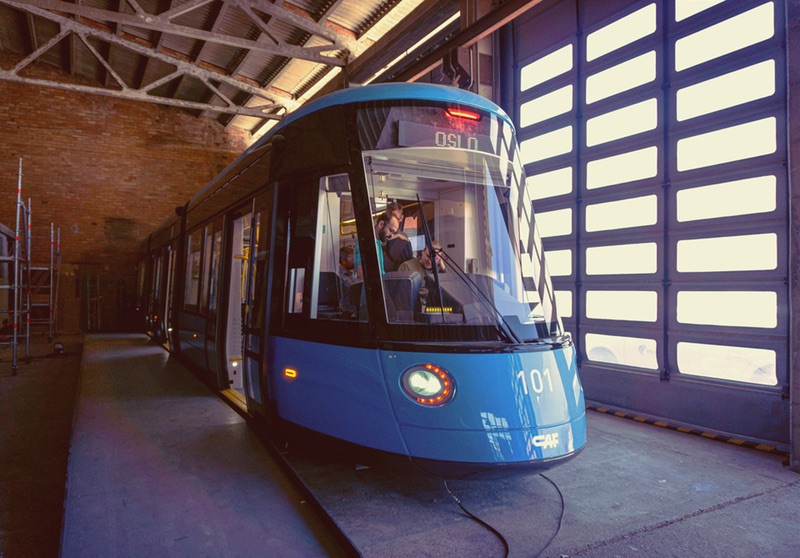
Buses in Oslo
You will find two types of public bus in Oslo. The red ones are local buses, criss-crossing Oslo and providing links to all areas not served by one of the other forms of transport. The green buses are regional buses. They travel much further afield and generally start and end at Oslo bus terminal.
City bus line 30 to Bygdøy is the most popular for tourists. This service takes visitors to many of Oslo's best museums, including the Viking ship museum and Kon-Tiki.
An important distinction to note is on the green regional buses you must enter at the front and show your ticket. On the red local buses you can enter using any door. You only need to scan your card if you need to validate it or use it to pay for a single journey.
Passenger ferries
Your ticket is valid on a limited number of passenger ferries that serve the small islands of the Oslofjord. They all fall within zone 1. That includes Hovedøya, Lindøya, Nakholmen, Bleikøya, Gressholmen and Langøyene. These ferries all leave from the well-marked pier in front of Oslo City Hall.
Some commuter ferries also link Oslo with Nessoden and other towns further down the Oslofjord. You'll find these from a neighbouring pier closer to Aker Brygge. These ferries will require at least a two-zone ticket.
There is also a summer-only tourist ferry shuttle from the City Hall to Bygdøy. This used to be part of the public transport system and was covered by regular tickets. However, this ferry now has a separate ticketing system and is not covered by a regular transport ticket.
How much does public transport cost?
One thing that makes travelling on Oslo's public transit easier is the ticketing system. Regardless of which mode of transport you choose, you only need to buy one ticket. This is the case even if you are connecting from metro to bus, tram to metro, or any other combination.
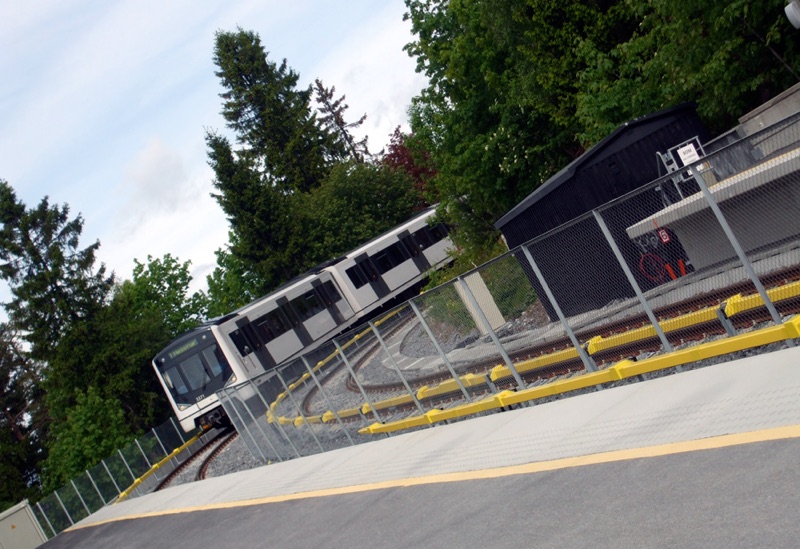
Ruter sets the pricing and has recently streamlined its charges into a simpler zonal system. The prices for valid for all buses, trams and local trains. The whole city of Oslo falls into Zone 1, ensuring you know what you will pay, wherever you are going.
Current prices for travel within Oslo
Here are the latest prices for a single ticket. Each ticket lasts for 60 minutes and is transferrable. This means you can use two modes of transport to complete your single journey, as long as you complete it within one hour.
- Single ticket (advance) – 40kr
- Single ticket (on board) – 60kr
- 24-hr ticket – 121kr
- 7-day ticket – 335kr
- 30-day ticket: 853kr
- 365-day ticket: 8,531kr
Please note: These prices were last updated in January 2023 and are valid for Oslo only. Travelling beyond the city limits is more expensive. Seniors (67+) and children (under 16) pay half.
For Oslo residents, I do not recommend buying the yearly ticket despite the price saving, because if you lose it, you're stuffed! Plus if you spend a lot of time away from the city and are clever with planning monthly ticket purchases, it's unlikely to save much over the year.
From personal experience, I find the 30-day ticket to provide the best balance of value and convenience. But of course, it's up to you!
For tourists spending more than two days, the 7-day ticket offers the best value. If you're planning to visit a lot of attractions, you could also consider the Oslo Pass. This includes entrance to many attractions as well as including all public transport.
Ticket checks in Oslo
Public transport in Oslo runs mainly on the honour system. However, checks (called kontroll in Norwegian) are common, yet random. Some locals claim they never get “controlled”, whereas others complain it happens on a weekly basis. The best thing to do? Buy a valid ticket!
Remember. If you buy a senior or children ticket, you might be asked to prove your age.
Sometimes inspectors step onto the bus or tram, or they could be waiting at stations. This is especially common in the city centre metro stations.
If you cannot present a valid ticket when challenged, you will be heavily fined. At the time of writing, the fine is 1,150kr. That fee is reduced to 950kr if you pay immediately. However, if you present a fake or forged ticket, the fine is 2,000kr.


Do you know whether the public transport at Oslo is available at 25th December? I’m going to travel there during Christmas vacation. Thanks.
Hi! The buses run every day of the year – but they do not run as often on December 25th. On ruter.no you can check the bus times for that day. In general though all buses should be running that day. If you are using the 31 bus or 37 bus they even go 24/7 all days of the year, so those lines are certain to go.
will i be able to purchase a seven day transit pass at the oslo s station? if so, where in the station?
thank you!
Yes, from the ticket desks or the kiosks (7-Eleven / Narvesen)
Hi do you know the best way to get from Oslo to Torf airport on Sundays please?
Hi, it’s the same as any other day. You can take a train to Torp station (a free shuttle bus meeting all trains runs to the airport terminal) or you can take an airport coach from the Oslo Bus Station. Train timetables at NSB and bus times at Torp Ekpressen. You can also find general travel information at Norway Traveller. Have a great trip!
Hi there, do ferries run from oslo city centre across to Polar Ship Fram in December?
No this is a summer only service, but there is a public bus.
Hi. If I buy a 7 day travel pass, can I use it to travel on the trains, trams and buses . Will I be able to buy it from the airport and use it to get to the first millenium hotel in the city. Also can you advise me on the cheapest 1 day round trip to see the fjords.
Trams, buses and trains yes, but only within the Oslo city boundary. You’ll find the map on the Ruter page. To get to the city from the Airport you can choose between express train, regular train or airport coach. Regular train is cheapest. One day is not really long enough to see the fjords from Oslo, you might be able to make it to Flåm and back, but I’m not sure that would give you time for a boat trip aswell. It all depends on what you want to see. Good luck with your trip! You can see more travel info on http://www.norwaytraveller.com
Hi David,
thanks for the precious info you’re providing. I ‘d like to ask your advice for a particular issue. It happened once that I went on the bus in Oslo and the ticket controllers were there. I had my ticket with me but it turned out to be invalid at the device check. I got very upset knowing for sure not to have used it before. I tried to explain the thing to the agents but failed to convince them. They gave me a fine (1150 kr). Later on I receive a giro by Demand Norge AS to pay 1.449 kr. My questions to you are: What happens if I don’t pay? And what leagal means can Demand Norge use against me in that case?
Look forward to your reply.
Marco
Hi David,
Do you know if one can use a 30-days ruter ticket for all the public transport systems, either bus, metro, tram and local trains running by NSB connecting zone 1 to zone 2?
are the 30-days tickets unlimited?
Thanks
Hi, I think so yes but you would need a 2-zone ticket not the 1-zone. Check with ruter.no, they have a full English translation
Hi David
I plan to buy the 24 hour ticket which have zone 1 , 2 zone and all zone. I have no idea which one I have to buy.
place I will go
Frognerparken (vigelandsparken) , Bygdoy ( Norsk folkemuseet) and airport.
Thank you very much
An all-zone 24-hr ticket will only be cheapest if you are travelling twice to/from the airport within the same day, and is only valid on the NSB trains (not the Airport Express). Everything in Oslo city itself is zone 1. The system is explained entirely in English on ruter.no
Hi, David!
We will be in Oslo on 30 and 31 December. Ist the 24-hour ticket valid for all transpots in Oslo? Can I use this ticket several times a day? At what age should I buy children a ticket? They are 8 years old.
Thank you!!!
Kind regards,
Diana
Hi, Are small dogs allowed to travel on public transport?
Thanks!
Michele
Hi,
I want to take the 30 bus first thing on a Wednesday morning towards the Viking Museum, do you know what time the first bus would run?
Thank you!
You can check the timetables on ruter.no, which has a full English translation
To all folks asking these stupid (detailed) questions –
if you are not able to check such a simply things like timetable you should rather stay at home than travel abroad.
T David Nikel –
thank you very much for your wonderful, informative website, especially for sharing your experience about Norwegian lifestyle, Hurtigruten, culture, etc. Please, don’t waist your time and energy trying to politely explain all the details which are easy accessible in English on the internet. Thank you for your patience and politeness, anyway!
Robert
Hi,
What’s the best way to get to the airport from trosterud at around 5am?
Thanks!
The airport bus calls at Trosterud on the E6 as far as I know. Check timetables on flybussen.no
Are small dogs allowed on buses in Oslo
Hi there.
What’s the best route to go to Skillingmarkvegen, 2233 Vestmarka, from the Oslo airport please?
thank you 🙂
You can use the route planner on the Ruter website, linked in the article. You can check Google Maps to find the closest bus stop.
What are the operating hours of the T-Bane?
Roughly 6am to midnight, but it depends on the specific line. You can find the timetables on the Ruter website, linked in the article.
Since April 2016 the Oslo Metro (T-bane) lines have been numbered 1 to 5 (not 6). For the latest official map, see https://ruter.no/globalassets/rutetabeller/t-bane/t-banen-linjekart-03042016.pdf
Hi
I am planing to come oslo on 18th April and Leave on 21st april so is the public transport working on those days please.
If you buy a weekly ticket, do you have to validate every trip, or do you just do it once and then you are set for the week provided you have in your pocket?
Thanks
Dear madam or sir,
I’m a French writer and for a novel I’m working on I’m looking for information about the Måløy-Oslo bus connection in 1978.
For example, I would like to know if there was a direct bus between Måløy and Oslo at that time, and if it was daily? If there was no direct bus, do you know which cities one had to go through? Stryn and Otta?
Also, do you have a rough idea of the timetable, prices and itinerary for such a voyage at that time?
Hope you can answer me, even though I know it’s been a long time.
Anyway I wish you the best,
Michel Gabout